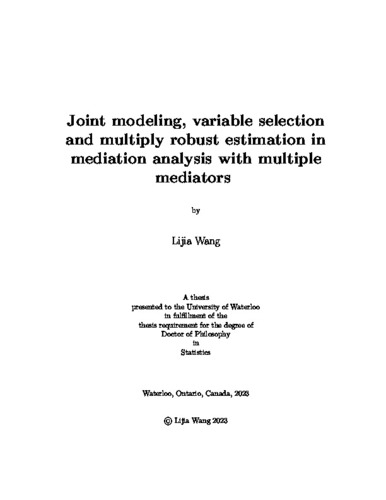| dc.description.abstract | This thesis explores topics in causal mediation analysis with multiple possibly related mediators. The goal of this thesis is to propose innovative methodologies for joint modeling of multiple uncausally related mediators, selecting mediators from high-dimensional candidates while simplifying their dependency structures and performing multiply robust estimations to uncover causal effects of interest.
Causal mediation analysis aims to enhance understanding of the effects of an exposure on an outcome by examining direct and indirect effects. In settings where multiple mediators are involved, the relations among these mediators play an important role. Traditional studies focus on the scenario that the multiple mediators are either related under specified causal structures or independent given baseline covariates. Our studies focus on multiple uncausally related mediators, where the mediators are associated with each other conditioning on pre-treatment covariates and treatment but there is no causal ordering among them.
In Chapter 2, we begin by reviewing and expanding upon the concept of mediators that are uncausally related, followed by the introduction of causal effects defined under such settings and the associated identification assumptions. We propose to jointly model the uncausally related mediators using copula functions. An important advantage of employing copula functions in joint modeling is the significant flexibility it offers, as this method allows for multiple mediators to have different distributions and be correlated in various ways. Subsequently, we propose methods estimating causal effects within this framework.
In Chapter 3, we center our attention on the sparse mediation phenomenon, where only a handful of true mediators, from a pool of possibly high-dimensional candidates, exhibit nonzero indirect effects. We propose a LASSO-based penalization technique that selects the true mediators by considering their indirect effects. Acknowledging that the selected mediators often still exhibit complex dependency structures even after selection, our method also simplifies these structures by selecting non-zero correlation entries within the correlation matrix using a similar penalized estimation technique. To facilitate the correlation structure selection, we transform the correlation matrix selection problem into a standard variable selection problem within the framework of a linear model. Moreover, our proposed method allows the mediator selection and the dependency structure selection processes, to be conducted either via either a parallel or a sequential approach. The grouped and individual causal effects are defined under such settings with estimation approaches discussed.
In Chapter 4, we discuss the issue of model misspecification within the context of causal mediation analysis. Following the discussion, we propose two ways of constructing multiply robust estimators. In causal mediation analysis, typically three working models must be specified: the treatment model, the mediator model, and the response model. Both of our multiply robust estimation methods yield consistent estimation of the causal quantities of interest, provided that any two out of the three models are correctly specified.
For each proposed method introduced in Chapters 2, 3 and 4, we provide theoretical results with proofs of the consistency and other properties. We also derive large sample properties and investigate finite sample properties via simulations. Each chapter includes an application of the proposed method to a genetic study in psychiatry to investigate DNA methylation loci as mediators on the causal path between childhood trauma and stress reactivity. In Chapter 2, the proposed method estimates the mediation effects of three DNA loci on the Kit ligand gene. Chapter 3 extends this analysis and applies the proposed mediator selection method to the entire DNA methylation dataset, revealing 12 mediating loci, with 10 showing a strong association. We estimate the grouped indirect effect from them and the individual effects of the remaining two loci. In Chapter 4, we employ our multiply robust estimation methods to re-evaluate the mediation effects of these 12 loci, demonstrating enhanced robustness to previous findings. | en |

